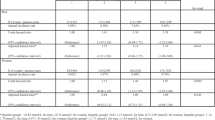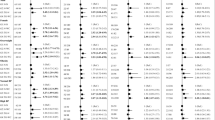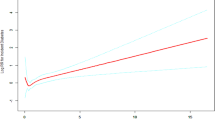Abstract
Background:
Few studies suggest that the combined increase in plasma triglycerides (TG) and in waist circumference (WC), termed ‘hypertriglyceridemic waist’ (HTGW), is an interesting marker of risk for cardiovascular disease (CVD).
Objective:
Using cutoffs used for defining HTGW, we examined the prospective association of HTGW with CVD risk in a French cohort of men.
Design:
Men were participants in the SU.VI.MAX study, an intervention trial testing the impact of an antioxidant supplementation on chronic diseases. Data were collected in 1994–1996 in 3430 men followed up for 7.5 years. Cutoffs used for defining HTGW were WC ⩾90 cm and TG ⩾2 mmol/l. We assessed the relative risk (RR) (95% confidence interval (CI)) of CVD in groups defined according to both WC and TG levels.
Results:
In this population, 41.2% of the subjects were classified as low WC/low TG, 43.2% as high WC/low TG, 3.5% as low WC/high TG and 12.1% as HTGW. During follow-up, 122 subjects had a CVD event. In this group, HTGW prevalence was 26.2%. After adjustment for age, RR (95% CI) for CVD for the HTGW group showed the highest association with CVD risk: 2.13 (1.21–3.76), using low WC/ low TG as the reference group.
Conclusion:
HTGW was associated with the risk of CVD after 7.5 years of follow-up in a low-risk middle-aged men population. This marker may be used as a useful clinical tool to screen for men at risk of CVD.
This is a preview of subscription content, access via your institution
Access options
Subscribe to this journal
Receive 12 print issues and online access
$259.00 per year
only $21.58 per issue
Buy this article
- Purchase on Springer Link
- Instant access to full article PDF
Prices may be subject to local taxes which are calculated during checkout

Similar content being viewed by others
References
NCEP. Executive summary of The Third Report of The National Cholesterol Education Program (NCEP) Expert Panel on Detection, Evaluation, And Treatment of High Blood Cholesterol In Adults (Adult Treatment Panel III). JAMA 2001; 285: 2486–2497.
World Health Organisation. Obesity: preventing and managing the global epidemic. Report of a WHO Consultation on Obesity. WHO: Geneva, 2000. WHO Technical Report Series no. 894.
Larsson B, Svardsudd K, Welin L, Wilhelmsen L, Bjorntorp P, Tibblin G . Abdominal adipose tissue distribution, obesity, and risk of cardiovascular disease and death: 13 year follow up of participants in the study of men born in 1913. Br Med J (Clin Res Ed) 1984; 288: 1401–1404.
Oppert JM, Charles MA, Thibult N, Guy-Grand B, Eschwege E, Ducimetière P . Anthropometric estimates of muscle and fat mass in relation to cardiac and cancer mortality in men: the Paris Prospective Study. Am J Clin Nutr 2002; 75: 1107–1113.
Rimm EB, Stampfer MJ, Giovannucci E, Ascherio A, Spiegelman D, Colditz GA et al. Body size and fat distribution as predictors of coronary heart disease among middle-aged and older US men. Am J Epidemiol 1995; 141: 1117–1127.
Czernichow S, Bertrais S, Galan P, Blacher J, Oppert J-M, Ducimetiere P et al. Body composition and fat repartition in relation to structure and function of large arteries in middle-aged adults (the SU.VI.MAX. Study). Int J Obes Relat Metab Disord 2005; 29: 826–832.
Janssen I, Katzmarzyk PT, Ross R . Waist circumference and not body mass index explains obesity-related health risk. Am J Clin Nutr 2004; 79: 379–384.
Fujimoto WY, Bergstrom RW, Boyko EJ, Chen KW, Leonetti DL, Newell-Morris L et al. Visceral adiposity and incident coronary heart disease in Japanese-American men. The 10-year follow-up results of the Seattle Japanese-American Community Diabetes Study. Diabetes Care 1999; 22: 1808–1812.
Pouliot MC, Despres JP, Lemieux S, Moorjani S, Bouchard C, Tremblay A et al. Waist circumference and abdominal sagittal diameter: best simple anthropometric indexes of abdominal visceral adipose tissue accumulation and related cardiovascular risk in men and women. Am J Cardiol 1994; 73: 460–468.
Bos G, Dekker JM, Nijpels G, de Vegt F, Diamant M, Stehouwer CD et al. A combination of high concentrations of serum triglyceride and non-high-density-lipoprotein-cholesterol is a risk factor for cardiovascular disease in subjects with abnormal glucose metabolism – The Hoorn Study. Diabetologia 2003; 46: 910–916.
Hokanson JE, Austin MA . Plasma triglyceride level is a risk factor for cardiovascular disease independent of high-density lipoprotein cholesterol level: a meta-analysis of population-based prospective studies. J Cardiovasc Risk 1996; 3: 213–219.
Talmud PJ, Hawe E, Miller GJ, Humphries SE . Nonfasting apolipoprotein B and triglyceride levels as a useful predictor of coronary heart disease risk in middle-aged UK men. Arterioscler Thromb Vasc Biol 2002; 22: 1918–1923.
Sharrett AR, Ballantyne CM, Coady SA, Heiss G, Sorlie PD, Catellier D et al. Coronary heart disease prediction from lipoprotein cholesterol levels, triglycerides, lipoprotein(a), apolipoproteins A-I and B, and HDL density subfractions: The Atherosclerosis Risk in Communities (ARIC) Study. Circulation 2001; 104: 1108–1113.
Lemieux I, Pascot A, Couillard C, Lamarche B, Tchernof A, Almeras N et al. Hypertriglyceridemic waist: a marker of the atherogenic metabolic triad (hyperinsulinemia; hyperapolipoprotein B; small, dense LDL) in men? Circulation 2000; 102: 179–184.
Despres JP, Lemieux I, Prud’homme D . Treatment of obesity: need to focus on high risk abdominally obese patients. BMJ 2001; 322: 716–720.
St Pierre J, Lemieux I, Vohl MC, Perron P, Tremblay G, Despres JP et al. Contribution of abdominal obesity and hypertriglyceridemia to impaired fasting glucose and coronary artery disease. Am J Cardiol 2002; 90: 15–18.
Kahn HS, Valdez R . Metabolic risks identified by the combination of enlarged waist and elevated triacylglycerol concentration. Am J Clin Nutr 2003; 78: 928–934.
Onat A, Ceyhan K, Basar O, Erer B, Toprak S, Sansoy V . Metabolic syndrome: major impact on coronary risk in a population with low cholesterol levels – a prospective and cross-sectional evaluation. Atherosclerosis 2002; 165: 285–292.
Tanko LB, Bagger YZ, Qin G, Alexandersen P, Larsen PJ, Christiansen C . Enlarged waist combined with elevated triglycerides is a strong predictor of accelerated atherogenesis and related cardiovascular mortality in postmenopausal women. Circulation 2005; 111: 1883–1890.
Tunstall-Pedoe H, Kuulasmaa K, Mahonen M, Tolonen H, Ruokokoski E, Amouyel P . Contribution of trends in survival and coronary-event rates to changes in coronary heart disease mortality: 10-year results from 37 WHO MONICA project populations. Monitoring trends and determinants in cardiovascular disease. Lancet 1999; 353: 1547–1557.
Yusuf S, Hawken S, Ounpuu S, Dans T, Avezum A, Lanas F et al. Effect of potentially modifiable risk factors associated with myocardial infarction in 52 countries (the INTERHEART study): case–control study. Lancet 2004; 364: 937–952.
Hercberg S, Preziosi P, Briancon S, Galan P, Triol I, Malvy D et al. A primary prevention trial using nutritional doses of antioxidant vitamins and minerals in cardiovascular diseases and cancers in a general population: the SU.VI.MAX study design, methods, and participant characteristics. SUpplementation en VItamines et Mineraux AntioXydants. Control Clin Trials 1998; 19: 336–351.
Hercberg S, Galan P, Preziosi P, Bertrais S, Mennen L, Malvy D et al. The SU.VI.MAX study: a randomised, placebo-controlled trial of the health effects of antioxidant vitamins and minerals. Arch Intern Med 2004; 164: 1–8.
Walldius G, Jungner I, Holme I, Aastveit AH, Kolar W, Steiner E . High apolipoprotein B, low apolipoprotein A-I, and improvement in the prediction of fatal myocardial infarction (AMORIS study): a prospective study. Lancet 2001; 358: 2026–2033.
Lemieux I, Almeras N, Mauriege P, Blanchet C, Dewailly E, Bergeron J et al. Prevalence of ‘hypertriglyceridemic waist’ in men who participated in the Quebec Health Survey: association with atherogenic and diabetogenic metabolic risk factors. Can J Cardiol 2002; 18: 725–732.
LaMonte MJ, Ainsworth BE, DuBose KD, Grandjean PW, Davis PG, Yanowitz FG et al. The hypertriglyceridemic waist phenotype among women. Atherosclerosis 2003; 171: 123–130.
Arveiler D, Wagner A, Ducimetiere P, Montaye M, Ruidavets JB, Bingham A et al. Trends in coronary heart disease in France during the second half of the 1990s. Eur J Cardiovasc Prev Rehabil 2005; 12: 209–215.
Jeppesen J, Hein HO, Suadicani P, Gyntelberg F . Triglyceride concentration and ischemic heart disease: an eight-year follow-up in the Copenhagen Male Study. Circulation 1998; 97: 1029–1036.
Luc G, Bard JM, Ferrieres J, Evans A, Amouyel P, Arveiler D et al. Value of HDL cholesterol, apolipoprotein A-I, lipoprotein A-I, and lipoprotein A-I/A-II in prediction of coronary heart disease: the PRIME Study. Prospective Epidemiological Study of Myocardial Infarction. Arterioscler Thromb Vasc Biol 2002; 22: 1155–1161.
Lemieux S, Prud’homme D, Bouchard C, Tremblay A, Despres JP . A single threshold value of waist girth identifies normal-weight and overweight subjects with excess visceral adipose tissue. Am J Clin Nutr 1996; 64: 685–693.
Molarius A, Seidell JC . Selection of anthropometric indicators for classification of abdominal fatness – a critical review. Int J Obes 1998; 22: 719–727.
Wang J . Waist circumference: a simple, inexpensive, and reliable tool that should be included as part of physical examinations in the doctor's office. Am J Clin Nutr 2003; 78: 902–903.
Couillard C, Bergeron N, Prud’homme D, Bergeron J, Tremblay A, Bouchard C et al. Postprandial triglyceride response in visceral obesity in men. Diabetes 1998; 47: 953–960.
Acknowledgements
We express gratitude to Aline Couthouis for her help in preparing the paper. The SU.VI.M.AX project received support from public and private sectors.
Author information
Authors and Affiliations
Corresponding author
Rights and permissions
About this article
Cite this article
Czernichow, S., Bruckert, E., Bertrais, S. et al. Hypertriglyceridemic waist and 7.5-year prospective risk of cardiovascular disease in asymptomatic middle-aged men. Int J Obes 31, 791–796 (2007). https://doi.org/10.1038/sj.ijo.0803477
Received:
Revised:
Accepted:
Published:
Issue Date:
DOI: https://doi.org/10.1038/sj.ijo.0803477
Keywords
This article is cited by
-
Hypertriglyceridemic-waist phenotype is strongly associated with cardiovascular risk factor clustering in Chinese adolescents
Scientific Reports (2022)
-
Association of “hypertriglyceridemic waist” with increased 5-year risk of subclinical atherosclerosis in a multi-ethnic population: a prospective cohort study
BMC Cardiovascular Disorders (2021)
-
Predictors of metabolic abnormalities in phenotypes that combined anthropometric indices and triglycerides
BMC Complementary and Alternative Medicine (2016)
-
Genome- and epigenome-wide association study of hypertriglyceridemic waist in Mexican American families
Clinical Epigenetics (2016)
-
Association Between the Hypertriglyceridemic Waist Phenotype, Prediabetes, and Diabetes Mellitus Among Adults in Puerto Rico
Journal of Immigrant and Minority Health (2016)



